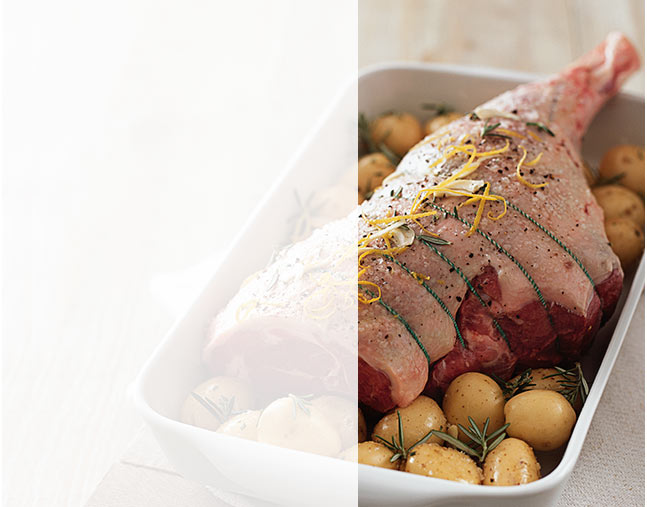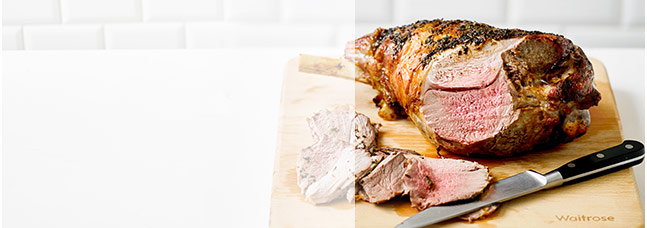Roast lamb
Versatile and delicious with the gusto to carry strong flavours, what's not to love about roast lamb?
Simply roasted with some garlic and rosemary, the juicy, sweet flavour of lamb makes a wonderful Sunday lunch. But lamb is versatile and can carry strong flavours and marinades. Some cuts of lamb are best slow cooked and others roasted in the more traditional way. Follow our guide for some simple tips and techniques to make the most of your lamb.
1) Choose the best cut
If you want a simple, lean roast lamb that’s crisp on the outside and pink and juicy in the middle, go for a leg of lamb. You can buy a whole leg, bone-in, part boned or boneless. A whole leg makes an impressive centrepiece and retains flavour from the bones – a boneless leg is easier to carve. For something in the middle, you could choose a part boned leg. A butterflied leg of lamb is a leg that has had the bone removed and the meat opened out into a vague ‘butterfly’ shape. This cut is often used for barbecuing, but also makes a great roast joint due to the flat shape of the meat and its quick cooking time.
A whole leg of lamb usually weighs between 2 – 2.75kg and will serve 6-8 people. If you’re cooking for a smaller group, a half leg is a good option.
Lamb shoulder is a fattier joint of meat and benefits from slow roasting at a lower temperature. It’s full of flavour and slow roasting produces a really tender result. Shoulder is also available boneless or part boned. Boneless lamb shoulder is usually rolled and tied. A 2.25kg shoulder should serve 6-8 people, and again if you’re cooking for a smaller crowd, a half shoulder is a good option.
If you’re cooking a boneless leg or shoulder, you’ll need to allow 225g of meat per person, so a joint for 6 should weigh between 1.5 - 2kg. Buy a slightly larger joint than you need if possible, as large joints tend to shrink less in the oven. You can always use up the leftovers another time.
Cooking just for 2? Rack of lamb or lamb fillet are more expensive cuts of meat, but can make a quick roast for 2 people with no waste. They both need pan frying first until browned to seal them as they’re leaner and the roasting time is shorter.

3) Get cooking
Take large joints of meat out of the fridge one hour before you want to cook them. This allows the meat to come to room temperature and it should cook more evenly. Calculate the cooking time according to the guide below. Arrange your oven shelves so that the meat will be positioned in the centre of the oven.
Preheat your oven to the correct temperature before you put the joint in, to ensure your cooking time is accurate. With larger roasting joints it’s a good idea to cook them for the first 20 minutes on a high heat, to let the heat really penetrate the meat and give a good crispy skin on the outside (there’s no need to use this method if you’re slow roasting a shoulder joint). If you are going to do this, preheat the oven to 220C/Gas 8. Remember to reduce the temperature after 20 minutes and deduct the 20 minutes from the total cooking time. You can leave the oven door open for a couple of minutes to help it cool down.
There’s no need to cover a leg of lamb with foil while it roasts. Due to the longer cooking time of slow roast shoulder, it’s a good idea to cover it with foil to help retain moisture. Take the foil off for the last 30 minutes of the cooking time to let the skin crisp up.
Whole, half or boneless shoulder

40 minutes per 500g, plus 40 minutes
Half leg, whole leg, boneless leg and part-boned shoulder

Half leg or whole leg
Medium – 25 minutes per 500g, plus 25 minutes
Well done – 30 minutes per 500g, plus 30 minutes
Boneless leg
30 minutes per 500g, plus 30 minutes
Part boned shoulder
60 minutes per 500g, plus 30 minutes
Lamb rack

Preheat a nonstick frying pan and fry the lamb on all sides over a high heat to seal the meat. Transfer to a small roasting tin and cook for:
Medium – 15-17 minutes
Well done – 20-22 minutes
4) Baste
Basting meat while it cooks simply means spooning the juices from the roasting tin back over the meat. Take the roasting tin out of the oven and tilt the tin slightly so that the fat and juices collect in one corner. Use a spoon or turkey baster to scoop them up and drizzle them over the meat. Baste the lamb 2 or 3 times while it’s cooking, and remember to shut the oven door while you do this so you don’t lose heat.
5) Check to see if it’s cooked
Slow roast lamb will be cooked through and slightly falling apart due to it’s longer cooking time, so the rules of medium, medium rare and well done don’t apply.
Roast leg of lamb is at it’s best served medium, but follow the roasting time guide to help you cook it how you like it. When the cooking time is up check your lamb by piercing the thickest part of the joint with a skewer. If the juices are pinky-red, the meat will be medium-rare. Slightly pink and it’s medium, and if you want it well done, they should run clear. A meat thermometer is very useful for large joints. Push the probe into the meat as close as possible to the centre (avoiding any bones) and leave it for 20 seconds before taking the reading. Medium should read 60C and well done 70C.







